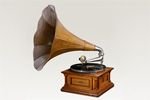Due to the Czech Republic being one of the leading European countries in this field since its very beginnings, the NTM’s collection of equipment for recording and reproducing sound is extensive.
The oldest devices for recording and reproducing sound – phonographs are represented by both the oldest Edison system on tinfoil and the Bell-Tainter system on wax and later celluloid cylinders. Here it is possible to find the first "jukebox" - a phonograph that started automatically started when a coin was put in, or a miniature Lioret phonograph for playing special cylinders mounted in a luxurious cigar box in the shape of an organ. The collection also includes cylinder dictaphones.
The gramophone collection includes a wide range of mechanical and electric gramophones. Among the most interesting are one of Berliner's very first hand-operated gramophones and the first Deutsche Grammophon A.G. gramophone model made in Europe. There are also Pathé or Edison devices with a different kind of sound recording system - depth, and a curious Klingsor gramophone with a resonant string system. The crown jewel of the collection is a table gramophone from the company His Master's Voice with a so-called Lumier membrane. Also noteworthy is the collection of miniature folding mechanical gramophones that were popular with tramps throughout the 1920s, 1930s and 1940s.
Among the electric gramophones are a number of table-top single-speed gramophones for playing standard records and several record-changers from the 1930s and 1940s. Post-war Czechoslovak production is very well represented with products from TESLA Litovel, ETA, and Elektro – Praga Hlinsko in the collection.
The collection of tape recorders captures the development of magnetic sound recording, from the oldest wire recorders to the latest types of tape recorders of both Czechoslovak and foreign production. An interesting feature of the collection is the Marconi-Stille for recording sound on a steel tape used in our national radio broadcaster at the turn of the 1930s and 1940s. The collection of tape recorders also includes studio tape recorders. One rare device in the collection is a Philips-Miller system for recording and reproducing sounds. The latter uses different physical principles for recording (mechanical) and for reproduction (optical).
At the same time, the collection is gradually being expanded to include home and portable CD players of domestic and foreign production, even though they are practically obsolete nowadays. In addition, various brands of MP3 players are also included in the collection.
Video technology is represented by cassette and reel-to-reel video recorders of various systems. They also include several video cameras and other accessories. The collection is continuously being expanded with the latest equipment and devices for optical recording - various combinations of DVD players/recorders with a VHS recorder or an HDD disk player or slots for various types of memory cards.

